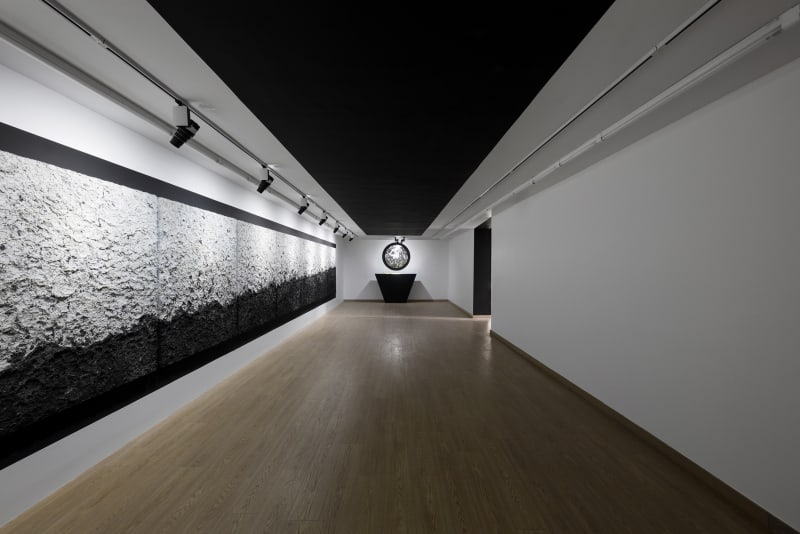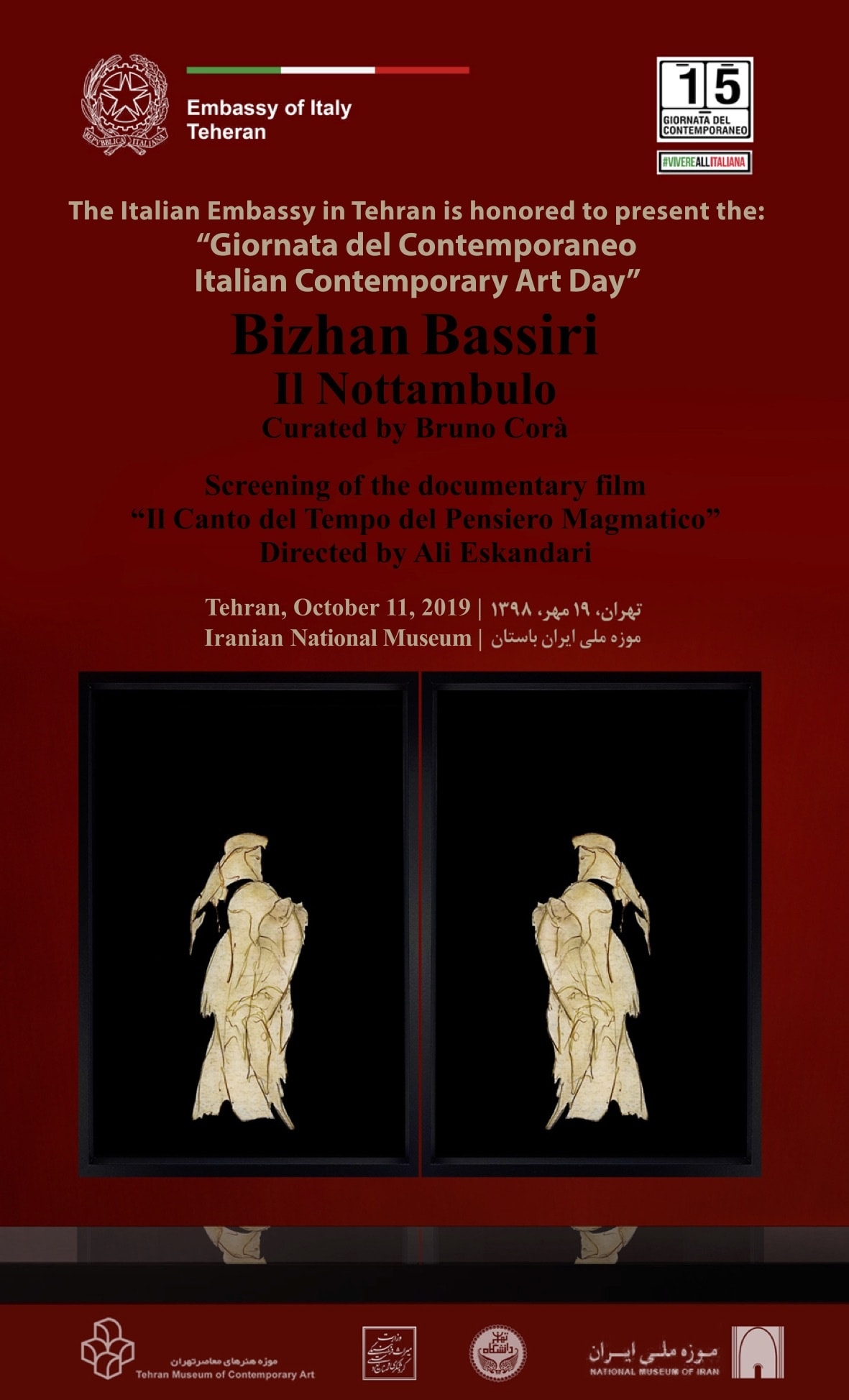Bizhan Bassiri | "Raad": Dastan+2
Bizhan Bassiri: The Sleepwalker on the Slope
Bruno Corà
The Slope:
"Rolling down
the mountain slope
resounded the short low sound
of the calmed incandescent body
in the dawn rising from the heart of madness
flowering phantom rooted in the earth
passing through the belly
venerable fertility amassed
together with the sea ... " (1)
Reciting these lines, thirty-five years ago, the sleepwalker climbing over the cold magma on the sides of the volcano Vesuvius appeared for the first time in the darkness barely lit by the moon. In the guise of a proud drawing The Prince (1982) of sleepwalking “On the slope of the bitter earth” (2) lingered waiting for the shower of meteorites to anticipate, “in the hours that precede the vision” (3), every future image, the outcome of continuous intuitions.
In yet another return to the places where he was born, Bizhan Bassiri, in an interlinking sequence of signs, evoking the horizon of the "Slope", reactivates emblems of an imagination that is far from fanciful, but rather fuelled by the inextinguishable flow of memory erupting like volcanic magma.
The first trace of this epic behaviour that Bassiri fuels with verses, drawings, sculptures and "evaporations" is found in Landscapes of the Mind (1978). The "Eccentric Prince" climbed the slope of the volcano on an initiatory journey, a sleepwalker in the darkness, where the figures of "Magmatic Thought", took on the guise and forms of phantoms, thoughts ready to receive the shower of meteorites for the duration of a lifetime.
It was at that moment that Bassiri experienced the epiphany of "Magmatic Thought", subsequently the first axiom of the Manifesto of Magmatic Thought.
"When I found myself on the crater for the first time, I experienced the magmatic state as though it were the blood circulating in the veins and the brain in a creative situation. Since then I have been a guest at this temple where phantoms take on a bodily form and stones look like sublime animals."
1. "The image precedes knowledge." (4)
Soon the outline of the mountainsides descending from the crater to sea level acquires a sculptural form, becoming a base/lectern for the poetic texts written during those years and subsequently the sloping surface bearing the lava heads of the Herms. Bassiri's "sloping pen", spilling ink in verses in the same style as the drawings, is inspired by the sloping sides of the volcano.
The moon and the serpent
In this Tehran exhibition Bassiri has visualized his aesthetic, poetic and artistic statement in a pictorial and sculptural synthesis, which evokes forms, concepts, emblems and linguistic modes that constitute the basis of his trajectory. While the "Slope" is both a real and imaginary place, since it is closely connected with the geological and magmatic dimension of the volcano, it is also the plane on which the incandescent matter flows dynamically from the bowels of the earth. Likewise thought erupts from the mind of man and takes shape through his actions and creations.
Every initiatory journey ¬– and the artistic journey too – begins in the poetic mind, in the darkness of a condition that art helps to illuminate. Dante, the greatest Italian poet, author of the three-part Divine Comedy, also evokes the condition of darkness in his cathartic journey from dark to light, from error to knowledge. In the first lines of the poem: "Midway upon the journey of our life / I found myself within a forest dark, / For the straightforward pathway had been lost." (Eng. trans. Henry Wadsworth Longfellow), he admirably describes how uneasy and lost we feel in the dark of the unknown journey of life.
In the darkness of Landscapes of the Mind and Landscapes of Magmatic Thought, dating from 1978, conceived and executed by Bassiri, the artist, in identifying with "sleepwalking" thought, constantly seeks signs and forms that guide him towards self-realization. In that obviously metaphorical darkness he walks by the light of the moon that helps him to find the path. Thus, way up high in the dark sky the disc of light that accompanies him is the moon, the proverbial interlocutor of poets. All nature comes to life in its luminous splendour and, before human beings, the animals, hidden and nourished by the earth. Among them the serpent, ancient mercurial emblem that takes on multiple guises: sword, sceptre, staff and others.
Many years have passed since the creation of this imaginary universe of images in Italy, a country that welcomed the young artist Bassiri, who brought with him the dreams of his native land. The different cultures fused in his mind, like a volcano that metabolizes everything in a magma. They have assumed diverse aspects of the forms constituting his changing repertoire, which developed from intuitions that later became the rules or generative principles of his work. By following the precepts in his Manifesto of Magmatic Thought, we discover the epic keys to his whole imaginative oeuvre. Here intuition and being open to amazement are states of consciousness that permanently welcome and readily transform the necessary material into art. Moreover, in order to "see" it is advisable to forget everything else when in the presence of his work, since, as Bassiri himself states, "Time and history are absent." (5)
(1) Bizhan Bassiri, Pensiero Magmatico e scrittura animale, AEIUO - Incontri Internazionali d'Arte, with a text by Bruno Corà, Rome,1985, p.1.
(2) Ibid.
(3) Bizhan Bassiri
(4) Bizhan Bassiri, Manifesto del Pensiero Magmatico, “Prologo” and “Punto 1”.
(5) Bizhan Bassiri, Manifesto del Pensiero Magmatico, “Punto 3”.










